1900-2100年中国陆地生态系统净生产力
IF 3.4
2区 环境科学与生态学
Q1 ECOLOGY
引用次数: 0
摘要
陆地生态系统是中国在2060年前实现碳(C)中和的关键二氧化碳(co2)汇。本文利用耦合模式比对项目第6阶段(CMIP6)模型的输出,量化了1900-2100年间净生态系统生产力(NEP)及其主要环境控制因素的时空格局,以及NEP的主要碳库。研究发现(a)根据CMIP6 NEP时空特征,中国陆地生态系统在1980-2014年期间吸收了0.310±0.058 Pg C·年-1,并将在未来(2015-2100年)扮演一个强碳库的角色[从共享社会经济路径126 (SSP126)下的0.515±0.075 Pg C·年-1增加到SSP585下的0.631±0.089 Pg C·年-1]。在历史(1984年)和4种未来排放情景下(SSP126为2057年、SSP245为2053年、SSP370为2038年和SSP585为2044年),NEP的时间趋势出现了明显的拐点。(b)在未来情景的每一个转折点之后,温度对新经济政策的积极影响似乎减弱了。(c)植被碳库规模的扩大主导着陆地生态系统碳储量的增长。CMIP6预测结果表明,各情景下中国陆地生态系统总碳储量持续增加,并在2040 ~ 2050年代达到峰值。未来东北、东南和西南地区的植树造林以及西北和中北部地区的土壤C库管理将极大地有助于中国实现碳中和,特别是在低排放情景下(SSP126)。本文章由计算机程序翻译,如有差异,请以英文原文为准。
Terrestrial net ecosystem productivity in China during 1900–2100
Terrestrial ecosystems are a critical carbon dioxide (CO 2 ) sink for achieving carbon (C) neutrality before 2060 in China. Here, we used the Coupled Model Intercomparison Project phase 6 (CMIP6) model outputs to quantify the spatiotemporal patterns of net ecosystem productivity (NEP) and its major environmental controls, as well as the dominant C pools for NEP during 1900–2100. We found that (a) according to CMIP6 NEP spatiotemporal characteristics, terrestrial ecosystems in China sequestered 0.310 ± 0.058 Pg C·year –1 during 1980–2014 and will act as a strong C sink [from 0.515 ± 0.075 Pg C·year –1 under Shared Socioeconomic Pathway 126 (SSP126) to 0.631 ± 0.089 Pg C·year –1 under SSP585] in the future (2015–2100). Pronounced turning points were found for the temporal trends of NEP during the historical (1984) and under 4 future emissions scenarios (2057 for SSP126, 2053 for SSP245, 2038 for SSP370, and 2044 for SSP585). (b) The positive effect of temperature on NEP appears to weaken after each turning point of future scenarios. (c) The enlarged vegetation C pool size dominates the growing terrestrial ecosystem C storage. The CMIP6 projection shows that the total C storage in Chinese terrestrial ecosystems increases continuously and peaks in the 2040s to 2050s under each scenario. Future afforestation in the northeast, southeast, and southwestern regions, as well as soil C pool management in the northwest and middle north regions, will greatly contribute to achieving C neutrality in China, particularly under low emission scenario (SSP126).
求助全文
通过发布文献求助,成功后即可免费获取论文全文。
去求助
来源期刊

Ecosystem Health and Sustainability
Environmental Science-Management, Monitoring, Policy and Law
CiteScore
7.10
自引率
2.00%
发文量
40
审稿时长
22 weeks
期刊介绍:
Ecosystem Health and Sustainability publishes articles on advances in ecology and sustainability science, how global environmental change affects ecosystem health, how changes in human activities affect ecosystem conditions, and system-based approaches for applying ecological science in decision-making to promote sustainable development. Papers focus on applying ecological theory, principles, and concepts to support sustainable development, especially in regions undergoing rapid environmental change. Papers on multi-scale, integrative, and interdisciplinary studies, and on international collaborations between scientists from industrialized and industrializing countries are especially welcome.
Suitable topics for EHS include:
• Global, regional and local studies of international significance
• Impact of global or regional environmental change on natural ecosystems
• Interdisciplinary research involving integration of natural, social, and behavioral sciences
• Science and policy that promote the use of ecological sciences in decision making
• Novel or multidisciplinary approaches for solving complex ecological problems
• Multi-scale and long-term observations of ecosystem evolution
• Development of novel systems approaches or modeling and simulation techniques
• Rapid responses to emerging ecological issues.
 求助内容:
求助内容: 应助结果提醒方式:
应助结果提醒方式:


